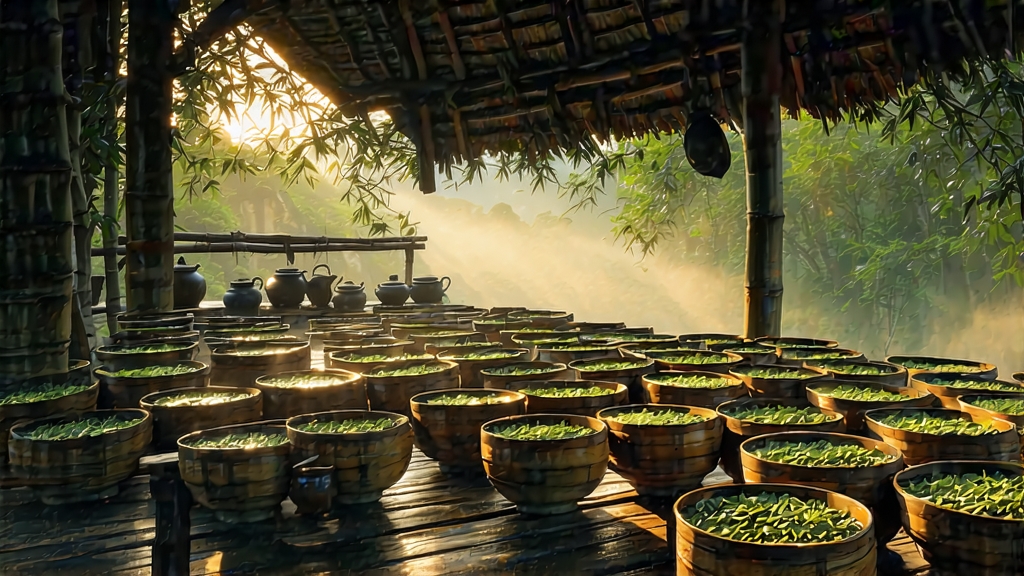
Ask most tea lovers to name China’s gift to the world of fully oxidized leaf and they will answer “black tea.” Few realize that the very first black tea ever created still survives, curled and fragrant, in the mist-wrapped Wuyi massif of northern Fujian. Locals call it Zheng Shan Xiao Zhong; the West knows it as Lapsang Souchong. More than a curiosity, this pine-smoked ancestor is a living time-capsule of terroir, trade and craftsmanship, and mastering its story is the surest way to understand how all black teas began.
History: From Mountain Hermit to Global Voyager
The accepted chronology places Lapsang’s birth in 1568, late-Ming dynasty, when a passing army commandeered Tongmu village for billets. Farmers, anxious that fresh leaves left in withering sheds would spoil overnight, dried them hastily over open pinewood fires. The accidental smoke infusion produced a dark, sweet liquor that travelled down the Nine-Dragon Gorge to the river port of Xingcun, where Dutch traders paid in silver. By 1604 the tea reached Amsterdam, outpricing green teas and prompting the European coinage “bohea” (from the local Wuyi range “Bohea Hills”). When the British East India Company transplanted Fujian cultivars to Assam and Ceylon in the 1840s, they carried with them the oxidation techniques first perfected on these very leaves. Thus every modern breakfast blend stands, however distantly, on Lapsang’s resinous shoulders.
Terroir: Where Rock, River and Fog Conspire
Tongmu and the three adjoining hamlets lie inside a national nature reserve at 27° N latitude, 700–1 400 m elevation. Granite cliffs temper the summer heat; the Chongyang and Tongmu creeks maintain 85 % humidity year-round. Day-night temperature swings of 10 °C slow leaf growth, concentrating amino acids and sugars. The forest floor exhahes terpenes from masson pine, cedar and camphor; the tea bushes—centuries-old seed-propagated specimens of the small-leaf Qizhong or “original bush” ecotype—absorb these aromatics much like grapes inhale garrigue in Provence. Within a radius of barely 60 km² the Chinese government has drawn a “core origin” circle; only leaf picked here may legally claim the designation Zheng Shan Xiao Zhong. Everything else is “wai shan” (outside mountain) and must be labelled simply smoked black tea.
Two Faces of the Same Leaf: Zheng Shan vs. Wai Shan
Purists recognize two stylistic lineages. Traditional Zheng Shan is withered over embers of local masson pine, fired three times in bamboo baskets, then briefly aged so that smoke integrates with malt. The result is glossy, jet-black strips that smell of longan, dried prune and campfire, yet steep into a burgundy liquor surprisingly soft and sweet. Since 2005 an unsmoked, “craft” version has emerged to suit modern palates: the same leaf is withered naturally and baked over charcoal made from lychee wood, yielding a honeyed cup with notes of caramel and ripe peach. Both styles share a short, fine twist called “sparrow-tongue” shape, but only the smoked version carries the European nickname “souchong,” from the Cantonese siu jung, “small sort.”
Craft: Turning Green into Memory
Plucking begins around Qingming festival when the standard “two leaves and a bud” measure exactly 2.5 cm. The leaf is cradled in shallow bamboo trays and withered for 8–10 h over pinewood fires held at 28–30 °C; smoke is never allowed to flame, only to sigh. Rolling follows for 45 min, breaking cell walls and initiating oxidation. The leaf is then swaddled in wet cloth and left for 3–4 h in a pine-panelled “fermentation room” where humidity hovers at 95 %. Oxidation complete, strips are fired twice—first “mao hong” (rough drying) at 100 °C for 20 min, then “zu hong” (足火,足火) at 80 °C for three hours—each time over a fresh pine ember bed. Finally the tea is rested for 30